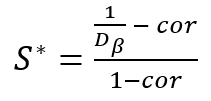The AHP consensus indicator, based on Shannon beta entropy (e.q. 1.1) for n criteria and k decision makers, was introduced in [1].
(1.1) Shannon beta entropy: 
(1.2) Shannon alpha entropy:
(1.3) Shannon gamma entropy: ![]()
with 
The similarity measure S (eq. 1.4) depends on the number of criteria, and we used a linear transformation to map it to a range from 0 to 1 (eq. 1.5)
(1.4)
(1.5) Consensus (0% to 100%): 
In general Dα min = 1 and Dγ max = n. In the analytic hierarchy process (AHP) Dα min is a function of the maximum scale value M (M = 9 for the fundamental AHP scale) and the number of criteria n (eq. 1.6). The calculation of Dγ max was based on the assumption that respondents compare one distinct criterion M‑times more important than all others (eq. 1.7).
(1.6) 
(1.7)
This assumption is actually an unnecessary constrain, because even when the number of decision makers is less than the number of criteria, both can prioritize a complementing set of criteria as most important and as a result all consolidated criteria weights are equal. Therefore eq. 1.7 can be simplified to:
(1.8) ![]()
As a result we get the AHP consensus indicator with:
(1.9) 
(1.10) AHP Consensus:  Equation (1.10) is used in the latest updated of the AHP excel template and the AHP-OS online software.
Equation (1.10) is used in the latest updated of the AHP excel template and the AHP-OS online software.
Reference
[1] Klaus D. Goepel, (2013). Implementing the Analytic Hierarchy Process as a Standard Method for Multi-Criteria Decision Making In Corporate Enterprises – A New AHP Excel Template with Multiple Inputs, Proceedings of the International Symposium on the Analytic Hierarchy Process, Kuala Lumpur 2013